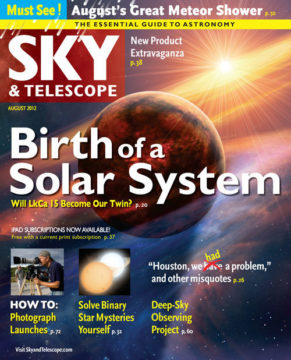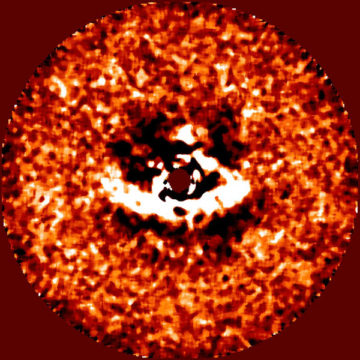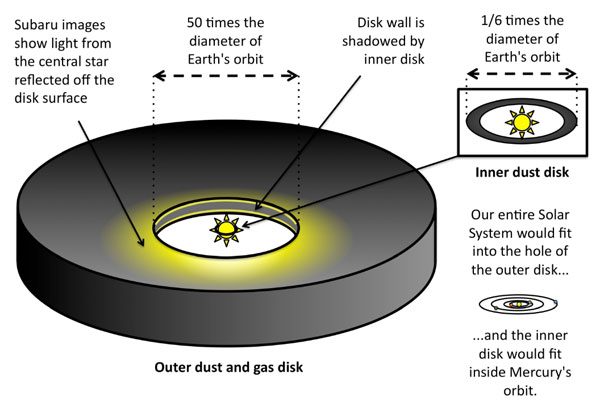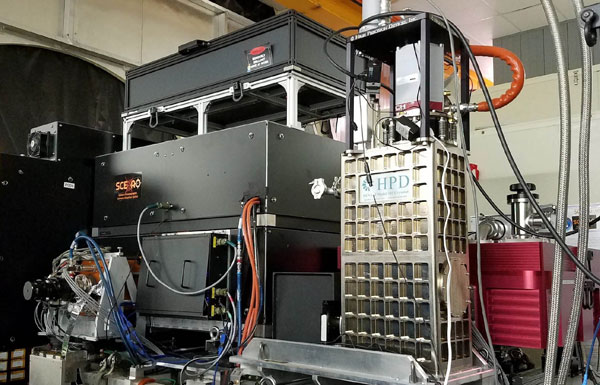Exceptional new images of the LkCa 15 system, a young, Sun-like star thought to host infant gas giant planets, shows those planets don't exist.

LkCa 15, a young Sun-like star, has excited astronomers ever since early research seemed to reveal evidence of planets — perhaps several of them — forming in the disk of gas and dust around the star. LkCa 15 is about as old as our Sun was when Jupiter and Saturn took shape, so these findings promised fresh insights into solar system formation. However, recent observations with the Subaru Telescope in Hawai‘i have generated sharper images than ever before, throwing these previous discoveries into question. It looks like the hunt for protoplanets around other stars is going to be challenging work.
As a protoplanet forms, it takes up dust and gas, clearing out a gap around its orbit. So finding a gap in LkCa 15’s disk seemed a good indication that planets were coming together there. Work using both interferometry and direct imaging suggested that up to three gas giants (LkCa 15 b, c, and d), all of them more massive than Jupiter, could be growing around the star. “These were the first protoplanets ever claimed,” says Thayne Currie (NASA-Ames Research Center, National Astronomical Observatory of Japan, and Eureka Scientific), lead author of a new study to appear in Astrophysical Journal Letters.

Subaru Telescope
But LkCa 15 is difficult to image directly, even for the powerful 8.2-meter Subaru Telescope. It’s about 500 light-years away and faint at visible wavelengths. Astronomers therefore searched around LkCa 15 with an advanced form of interferometry — called sparse aperture masking — but still found it hard to distinguish how much of the light was coming from potential planets and how much was coming from disk material.
The new study took advantage of two new tools to capture even sharper images of LkCa 15: the Subaru Coronagraphic Extreme Adaptive Optics (SCEXAO) system and the Coronagraphic High Angular Resolution Imaging Spectrograph (CHARIS). SCEXAO includes a deformable mirror with 2,000 actuators that adjust to correct for atmospheric blurring and a fast, ultra-sensitive camera. The sharp image that SCEXAO captured was then processed through CHARIS to reveal the spectrum of light sources around LkCa 15.
Currie and colleagues found that most of the light originates from the visible edge of another component of LkCa 15’s disk, an extended arc-like structure around the star. That structure has the same brightness as the signals previously attributed to protoplanets. The research team then dug deeper and reviewed complementary data on LkCa 15 taken at the Keck Observatory between 2009 and 2017. “Our Keck data shows that the arc was static over the eight years we examined,” says Currie. “If there were planets instead of a disk, their orbital motion would have rotated the arc.”

MPIA / Christian Thalmann
“What nails the result down,” says Adam Burgasser (University of California, San Diego), “is that the planets that had been predicted should have been in another location, and weren’t seen.” Burgasser was not involved in the new study.
“To be precise,” says Currie, “we’ve only ruled out multiple planets like LkCa 15 bcd. I think it’s very clear that there are planets around the star. They’re just fainter than we previously thought.”

Thayne Currie et al. / Astrophysical Journal Letters 2019
Kate Follette (Amherst College), who had directly imaged hydrogen-alpha emissions, agrees that the data still support the existence of at least one protoplanet in the LkCa 15 disk. “It’s hard to conclude that there aren’t planets,” she says. “It’s just a question of where they are and whether we’re detecting them directly or through indirect signatures. This paper is an additional piece of the puzzle. What we’re finding for all of these systems is that they’re extremely complicated.” Follette thinks the final resolution of this issue will come through future direct-imaging instruments.

Subaru Telescope
The study of distant stars like LkCa 15 demonstrates the risks of working on cutting-edge problems with evolving technologies. But technical capabilities are growing. “We’re continually upgrading SCEXAO,” says Currie. “Hopefully, we’ll have it performing at full power in a few years.” Improvements to SCEXAO may allow astronomers to see faint Jupiter-like planets moving against the background of the LkCa 15 disk. Eventually, a successor to SCEXAO — the Planetary Systems Imager — will be installed on the Thirty Meter Telescope to image even fainter, lower-mass planets in Mars-like orbits around stars like LkCa 15.
“This isn’t going to be the end of the story,” says Burgasser. “LkCa 15 is such an exceptional system that we’re going to have more studies to probe whether planets are forming there or not.”
 1
1
Comments
fif52
May 15, 2019 at 6:43 pm
An article by Sciency Thoughts based from an ESO team study have further items to add to this article including an inner main asteroid belt and 3 planets. They were using 'SPHERE' and the VLT.
Is this between a red giant star and white sub giant star, itself being an orange dwarf? (about the same distance but recorded distance varies).
You must be logged in to post a comment.
You must be logged in to post a comment.